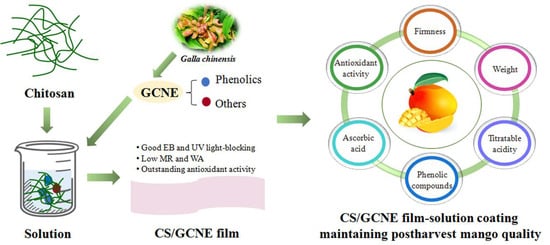Enhancement of the Physical and Functional Properties of Chitosan Films by Incorporating Galla chinensis Extract
Abstract
1. Introduction
2. Materials and Methods
2.1. Materials
2.2. Preparation and Characterization of the GCNE
2.3. Preparation of the Films
2.4. Structural Characterization of the Films
2.5. Mechanical Properties of the Films
2.6. Determination of the Physical Properties of the Films
2.7. Antioxidant Activity of the Films
2.8. Mango Preservation Application
2.9. Statistical Analysis
3. Results and Discussion
3.1. Properties of the GCNE
3.2. Internal Morphological Property of the Films
3.3. FTIR Analysis of the Films
3.4. Mechanical Properties of the Films
3.5. Color and Light Transmittance of the Films
3.6. MR, WA, and WVP of the Films
3.7. Antioxidant Activities of the Films
3.8. Mango Preservation Application
4. Conclusions
Author Contributions
Funding
Institutional Review Board Statement
Informed Consent Statement
Data Availability Statement
Acknowledgments
Conflicts of Interest
References
- Modesti, M.; Zampella, L.; Petriccione, M. Chitosan mono- and bilayer edible coatings for preserving postharvest quality of fresh fruit. In Polymers for Agri-Food Applications; Springer: Cham, Switzerland, 2019; pp. 465–486. [Google Scholar]
- Jiang, H.; Zhang, W.; Xu, Y.; Zhang, Y.; Pu, Y.; Cao, J.; Jiang, W. Applications of plant-derived food by-products to maintain quality of postharvest fruits and vegetables. Trends Food Sci. Technol. 2021, 116, 1105–1119. [Google Scholar] [CrossRef]
- Kan, M.; Miller, S.A. Environmental impacts of plastic packaging of food products. Resour. Conserv. Recy. 2022, 180, 106156. [Google Scholar] [CrossRef]
- Han, J.; Ruiz-Garcia, L.; Qian, J.; Yang, X. Food packaging: A comprehensive review and future trends. Compr. Rev. Food Sci. Food Saf. 2018, 17, 860–877. [Google Scholar] [CrossRef] [PubMed]
- Yang, X.; Lan, W.; Sun, X. Antibacterial and antioxidant properties of phenolic acid grafted chitosan and its application in food preservation: A review. Food Chem. 2023, 428, 136788. [Google Scholar] [CrossRef] [PubMed]
- Haghighi, H.; Biard, S.; Bigi, F.; Leo, R.D.; Bedin, E.; Pfeifer, F.; Siesler, H.W.; Licciardello, F.A. Pulvirenti, Comprehensive characterization of active chitosan-gelatin blend films enriched with different essential oils. Food Hydrocoll. 2019, 95, 33–42. [Google Scholar] [CrossRef]
- Zhang, X.; Ismail, B.B.; Cheng, H.; Jin, T.; Qian, M.; Arabi, S.A.; Liu, D.; Guo, M. Emerging chitosan-essential oil films and coatings for food preservation—A review of advances and applications. Carbohyd. Polym. 2021, 273, 118616. [Google Scholar] [CrossRef] [PubMed]
- Song, X.; Liu, L.; Wu, X.; Liu, Y.; Yuan, J. Chitosan-based functional films integrated with magnolol: Characterization, antioxidant and antimicrobial activity and pork preservation. Int. J. Mol. Sci. 2021, 22, 7769. [Google Scholar] [CrossRef]
- Yadav, S.; Mehrotra, G.K.; Bhartiya, P.; Singh, A.; Dutta, P.K. Preparation, physicochemical and biological evaluation of quercetin based chitosan-gelatin film for food packaging. Carbohyd. Polym. 2020, 227, 115348. [Google Scholar] [CrossRef]
- Perdones, A.; Escriche, I.; Chiralt, A.; Vargas, M. Effect of chitosan-lemon essential oil coatings on volatile profile of strawberries during storage. Food Chem. 2016, 197, 979–986. [Google Scholar] [CrossRef]
- Sun, K.; Song, X.; Jia, R.; Yin, Z.; Zou, Y.; Li, L.; Yin, L.; He, C.; Liang, X.; Yue, G.; et al. Affiliation evaluation of analgesic and anti-Inflammatory activities of water extract of Galla chinensis in vivo models. Evid. Based Complement. Alternat. Med. 2018, 2018, 6784032. [Google Scholar] [CrossRef]
- Lee, Y.H.; Hwang, E.K.; Baek, Y.M.; Kim, H.D. Deodorizing function and antibacterial activity of fabrics dyed with gallnut (Galla chinensis) extract. Text. Res. J. 2015, 85, 1045–1054. [Google Scholar] [CrossRef]
- Zhu, X.; Hou, X.; Ma, B.; Xu, H.; Yang, Y. Chitosan/gallnut tannins composite fiber with improved tensile, antibacterial and fluorescence properties. Carbohyd. Polym. 2019, 226, 115311. [Google Scholar] [CrossRef] [PubMed]
- Liu, W.; Kang, S.; Zhang, Q.; Chen, S.; Yang, Q.; Yan, B. Self-assembly fabrication of chitosan-tannic acid/MXene composite film with excellent antibacterial and antioxidant properties for fruit preservation. Food Chem. 2023, 410, 135405. [Google Scholar] [CrossRef] [PubMed]
- Zhao, S.; Jia, R.; Yang, J.; Dai, L.; Ji, N.; Xiong, L.; Sun, Q. Development of chitosan/tannic acid/corn starch multifunctional bilayer smart films as pH-responsive actuators and for fruit preservation. Int. J. Biol. Macromol. 2022, 205, 419–429. [Google Scholar] [CrossRef] [PubMed]
- Zhang, C.; Yang, Z.; Shi, J.; Zou, X.; Zhai, X.; Huang, X.; Li, Z.; Holmes, M.; Daglia, M.; Xiao, J. Physical properties and bioactivities of chitosan/gelatin-based films loaded with tannic acid and its application on the preservation of fresh-cut apples. LWT 2021, 144, 111223. [Google Scholar] [CrossRef]
- Zhang, X.; Liu, J.; Qian, C.; Kan, J.; Jin, C. Effect of grafting method on the physical property and antioxidant potential of chitosan film functionalized with gallic acid. Food Hydrocoll. 2019, 89, 1–10. [Google Scholar] [CrossRef]
- Sun, J.; Jiang, H.; Wu, H.; Tong, C.; Pang, J.; Wu, C. Multifunctional bionanocomposite films based on konjac glucomannan/chitosan with nano-ZnO and mulberry anthocyanin extract for active food packaging. Food Hydrocoll. 2020, 107, 105942. [Google Scholar] [CrossRef]
- Aloui, H.; Deshmukh, A.R.; Khomlaem, C.; Kim, B.S. Novel composite films based on sodium alginate and gallnut extract with enhanced antioxidant, antimicrobial, barrier and mechanical properties. Food Hydrocoll. 2021, 113, 106508. [Google Scholar] [CrossRef]
- Rhim, J.W. Physical and mechanical properties of water resistant sodium alginate films. LWT 2004, 37, 323–330. [Google Scholar] [CrossRef]
- Hou, X.; Zhu, X.; Li, J. Multifunctional Chitosan/Gallnut Tannin Blended Film and Preparation Method. CN111234324B, 28 December 2021. [Google Scholar]
- ASTM E96-05; Standard Test Method for Water Vapor Transmission of Materials. American Society for Testing Materials: Philadelphia, PA, USA, 2005.
- Peng, Y.; Wu, Y.; Li, Y. Development of tea extracts and chitosan composite films for active packaging materials. Int. J. Biol. Macromol. 2013, 59, 282–289. [Google Scholar] [CrossRef]
- Fan, X.; Zhang, B.; Yan, H.; Feng, J.; Ma, Z.; Zhang, X. Effect of lotus leaf extract incorporated composite coating on the postharvest quality of fresh goji (Lycium barbarum L.) fruit. Postharvest Biol. Technol. 2019, 148, 132–140. [Google Scholar] [CrossRef]
- Ali, S.; Khan, A.S.; Nawaz, A.; Anjum, M.A.; Naz, S.; Ejaz, S.; Hussain, S. Aloe vera gel coating delays postharvest browning and maintains quality of harvested litchi fruit. Postharvest Biol. Technol. 2019, 157, 110960. [Google Scholar] [CrossRef]
- Wang, J.; Hu, X.; Yang, C.; Wu, X.; Li, R.; Li, M. Growth restriction of Rhizoctonia solani via breakage of intracellular organelles using crude extracts of gallnut and clove. Molecules 2021, 26, 1667. [Google Scholar] [CrossRef] [PubMed]
- Bu, Y.; Kushwaha, A.; Goswami, L.; Kim, B.S. Green production of functionalized few-layer graphene–silver nanocomposites using gallnut extract for antibacterial application. Micromachines 2022, 13, 1232. [Google Scholar] [CrossRef] [PubMed]
- Lee, Y.H.; Hwang, E.K.; Kim, H.D. Colorimetric assay and antibacterial activity ofcotton, silk, and wool fabrics dyed with peony, pomegranate, clove, Coptis chinenis and gallnut extracts. Micromachines 2009, 2, 10–21. [Google Scholar]
- Luo, D.; Xie, Q.; Gu, S.; Xue, W. Potato starch films by incorporating tea polyphenol and MgO nanoparticles with enhanced physical, functional and preserved properties. Int. J. Biol. Macromol. 2022, 221, 108–120. [Google Scholar] [CrossRef] [PubMed]
- Hu, F.; Sun, T.; Xie, J.; Xue, B.; Li, X.; Gan, J.; Li, L.; Bian, X.; Shao, Z. Functional properties of chitosan films with conjugated or incorporated salicylic acid. J. Mol. Struct. 2021, 1223, 129237. [Google Scholar] [CrossRef]
- Zarandona, I.; Puertas, A.I.; Dueñas, M.T.; Guerrero, P.; Caba, K. Assessment of active chitosan films incorporated with gallic acid. Food Hydrocoll. 2020, 101, 105486. [Google Scholar] [CrossRef]
- Soni, B.; Hassan, E.B.; Schilling, M.W.; Mahmoud, B. Transparent bionanocomposite films based on chitosan and TEMPO-oxidized cellulose nanofibers with enhanced mechanical and barrier properties. Carbohyd. Polym. 2016, 151, 779–789. [Google Scholar] [CrossRef]
- Amri, F.; Husseinsyah, S.; Hussin, K. Mechanical, morphological and thermal properties of chitosan filled polypropylene composites: The effect of binary modifying agents. Compos. Part A Appl. Sci. Manuf. 2013, 46, 89–95. [Google Scholar] [CrossRef]
- Ma, Q.; Wang, L. Preparation of a visual pH-sensing film based on tara gum incorporating cellulose and extracts from grape skins. Sens. Actuators B Chem. 2016, 235, 401–407. [Google Scholar] [CrossRef]
- Sun, X.; Wang, Z.; Kadouh, H.; Zhou, K. The antimicrobial, mechanical, physical and structural properties of chitosan–gallic acid films. LWT 2014, 57, 83–89. [Google Scholar] [CrossRef]
- Zhang, W.; Jiang, W. Antioxidant and antibacterial chitosan film with tea polyphenols-mediated green synthesis silver nanoparticle via a novel one-pot method. Int. J. Biol. Macromol. 2020, 155, 1252–1261. [Google Scholar] [CrossRef] [PubMed]
- Yang, Y.; Shi, Y.; Cao, X.; Liu, Q.; Wang, H.; Kong, B. Preparation and functional properties of poly(vinyl alcohol)/ethyl cellulose/tea polyphenol electrospun nanofibrous films for active packaging material. Food Control 2021, 130, 108331. [Google Scholar] [CrossRef]
- Li, H.; Li, F.; Wang, L.; Sheng, J.; Xin, Z.; Zhao, L.; Xiao, H.; Zheng, Y.; Hu, Q. Effect of nano-packing on preservation quality of Chinese jujube (Ziziphus jujuba Mill. var. inermis (Bunge) Rehd). Food Chem. 2009, 114, 547–552. [Google Scholar] [CrossRef]
- Guo, X.; Chen, B.; Wu, X.; Li, J.; Sun, Q. Utilization of cinnamaldehyde and zinc oxide nanoparticles in a carboxymethylcellulose-based composite coating to improve the postharvest quality of cherry tomatoes. Int. J. Biol. Macromol. 2020, 160, 175–182. [Google Scholar] [CrossRef]
- Klangmuang, P.; Sothornvit, R. Active hydroxypropyl methylcellulose-based composite coating powder to maintain the quality of fresh mango. LWT 2018, 91, 541–548. [Google Scholar] [CrossRef]
- Xing, Y.; Xu, Q.; Che, Z.; Li, X.; Li, W. Effects of chitosan-oil coating on blue mold disease and quality attributes of jujube fruits. Food Funct. 2011, 2, 466–474. [Google Scholar] [CrossRef]
- Supriya, A.; Kumar, A.; Kudachikar, V.B. A comparison investigation on antioxidant activities, constitutive antifungal phenolic lipids and phenolics contents of anthracnose resistant and susceptible mango fruit cultivars. Int. J. Fruit Sci. 2020, 20, 692–704. [Google Scholar] [CrossRef]
- Xing, Y.; Li, X.; Xu, Q.; Yun, J.; Lu, Y.; Tang, Y. Effects of chitosan coating enriched with cinnamon oil on qualitative properties of sweet pepper (Capsicum annuum L.). Food Chem. 2011, 124, 1443–1450. [Google Scholar] [CrossRef]
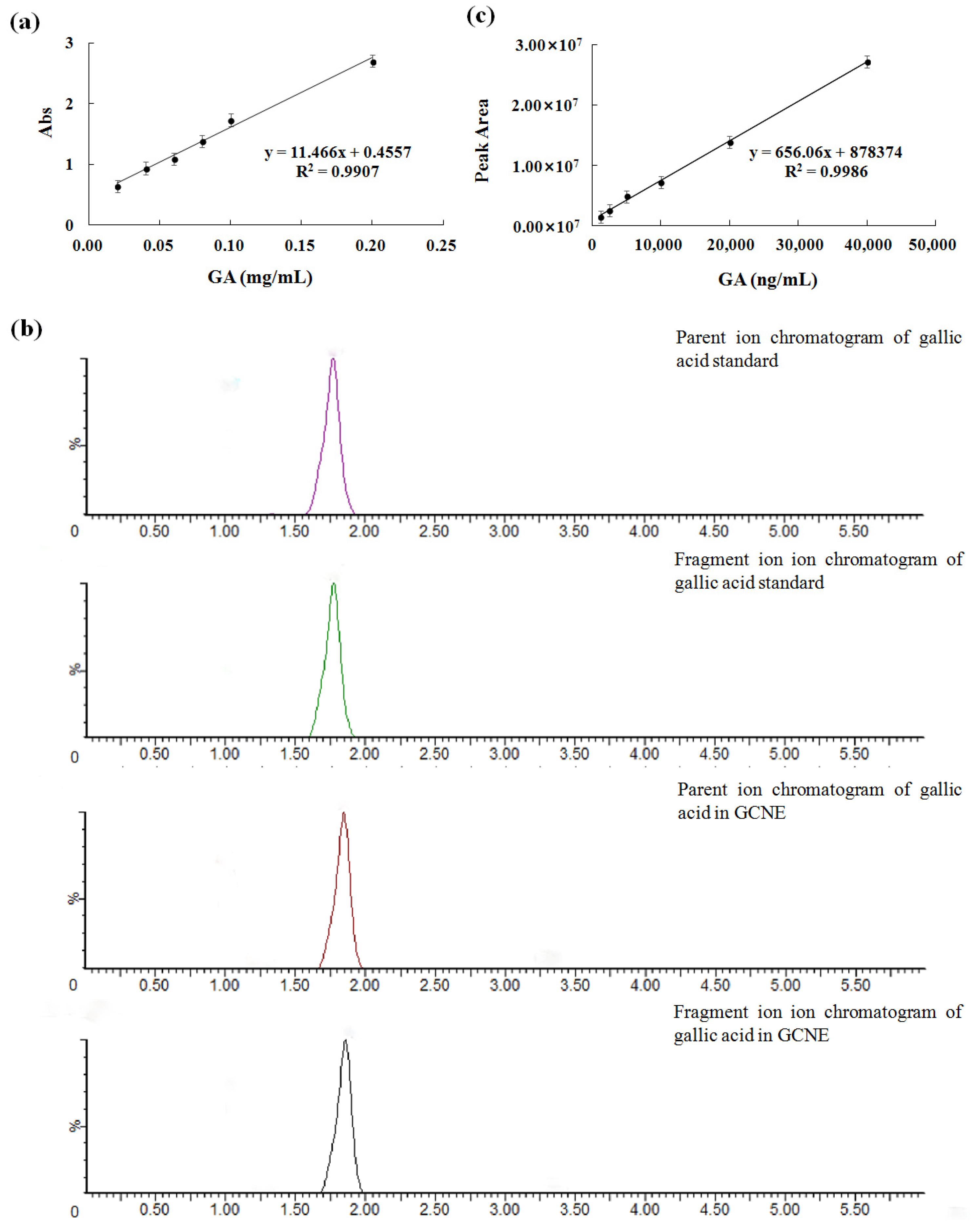
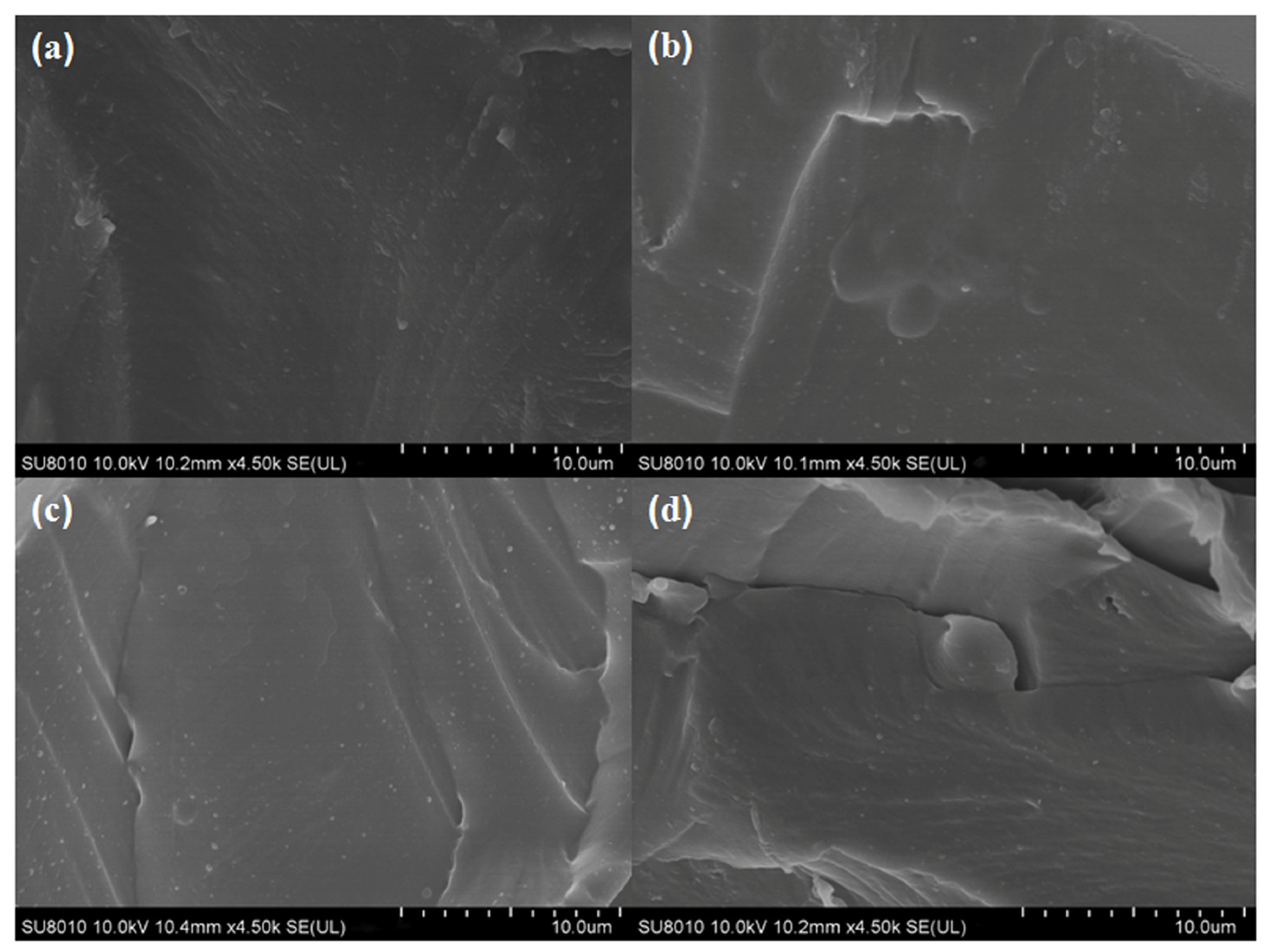
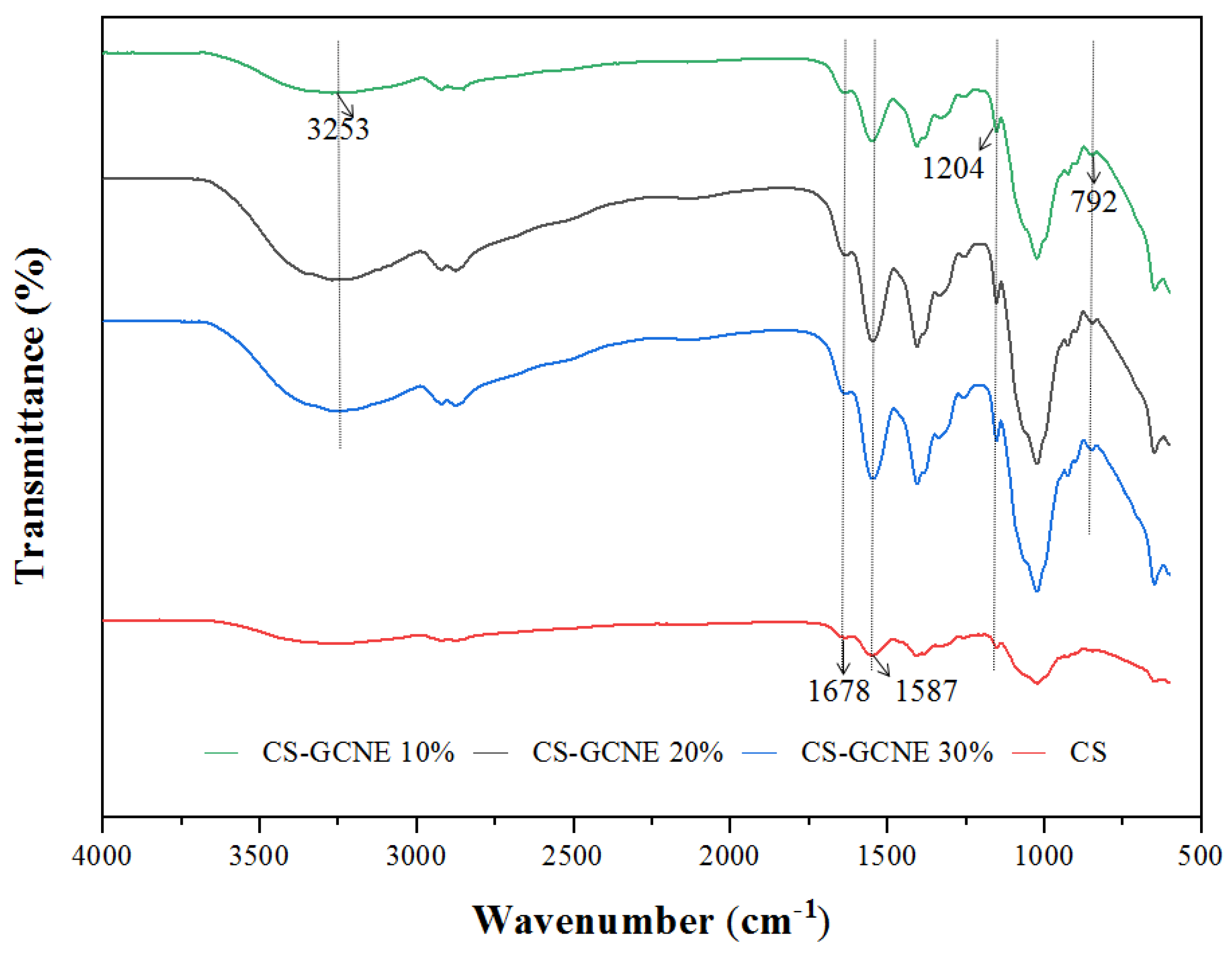
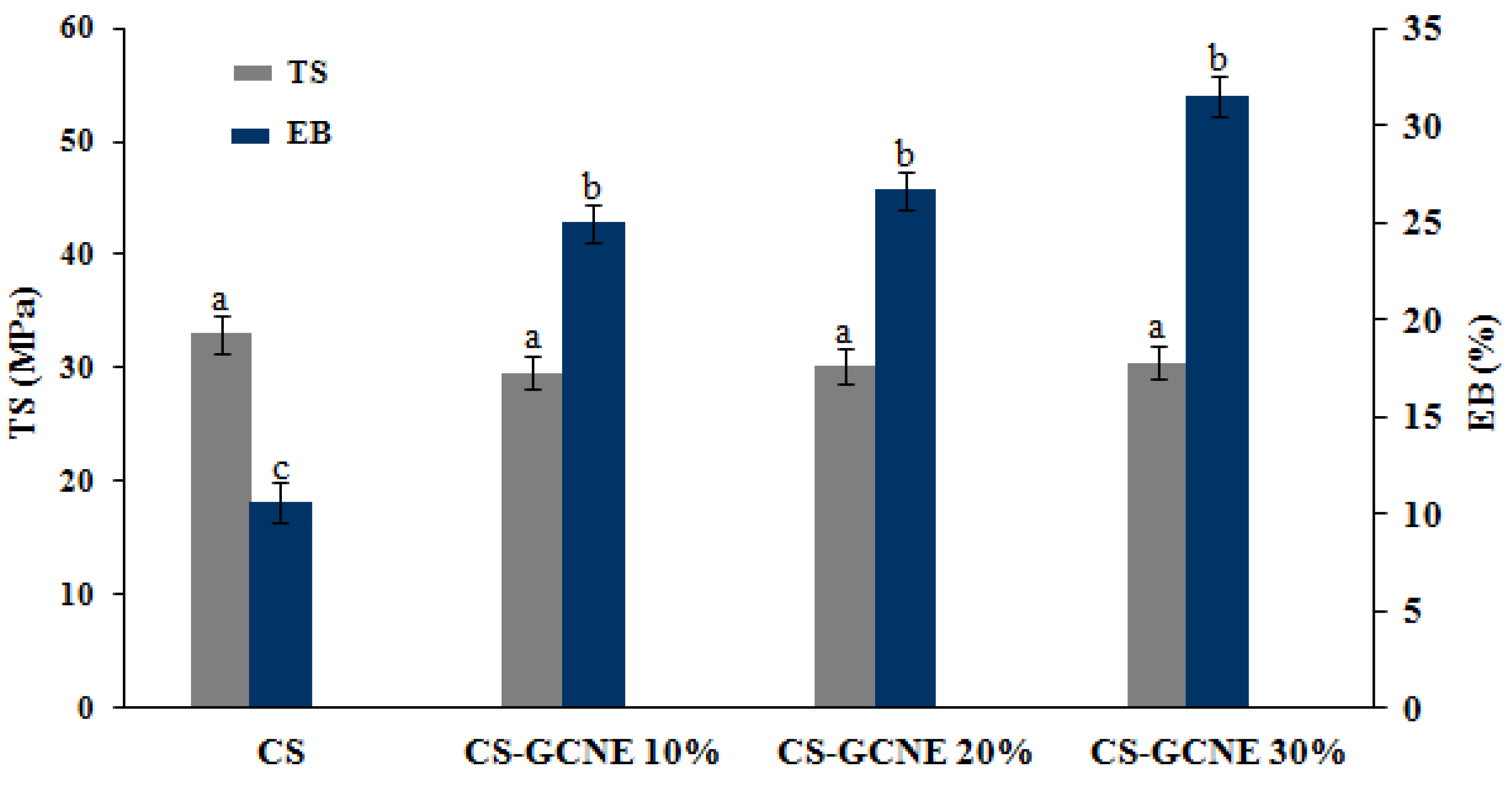
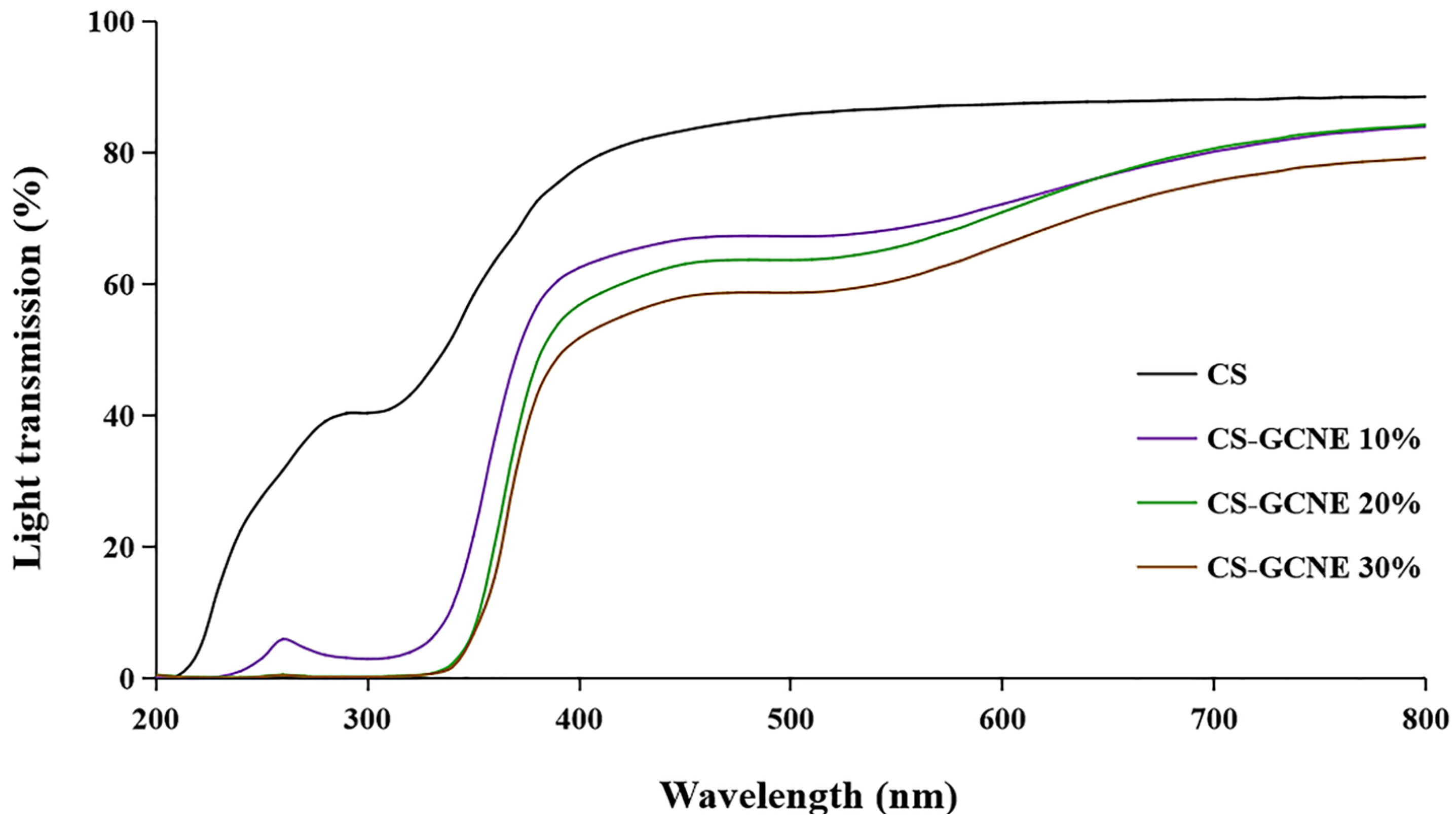
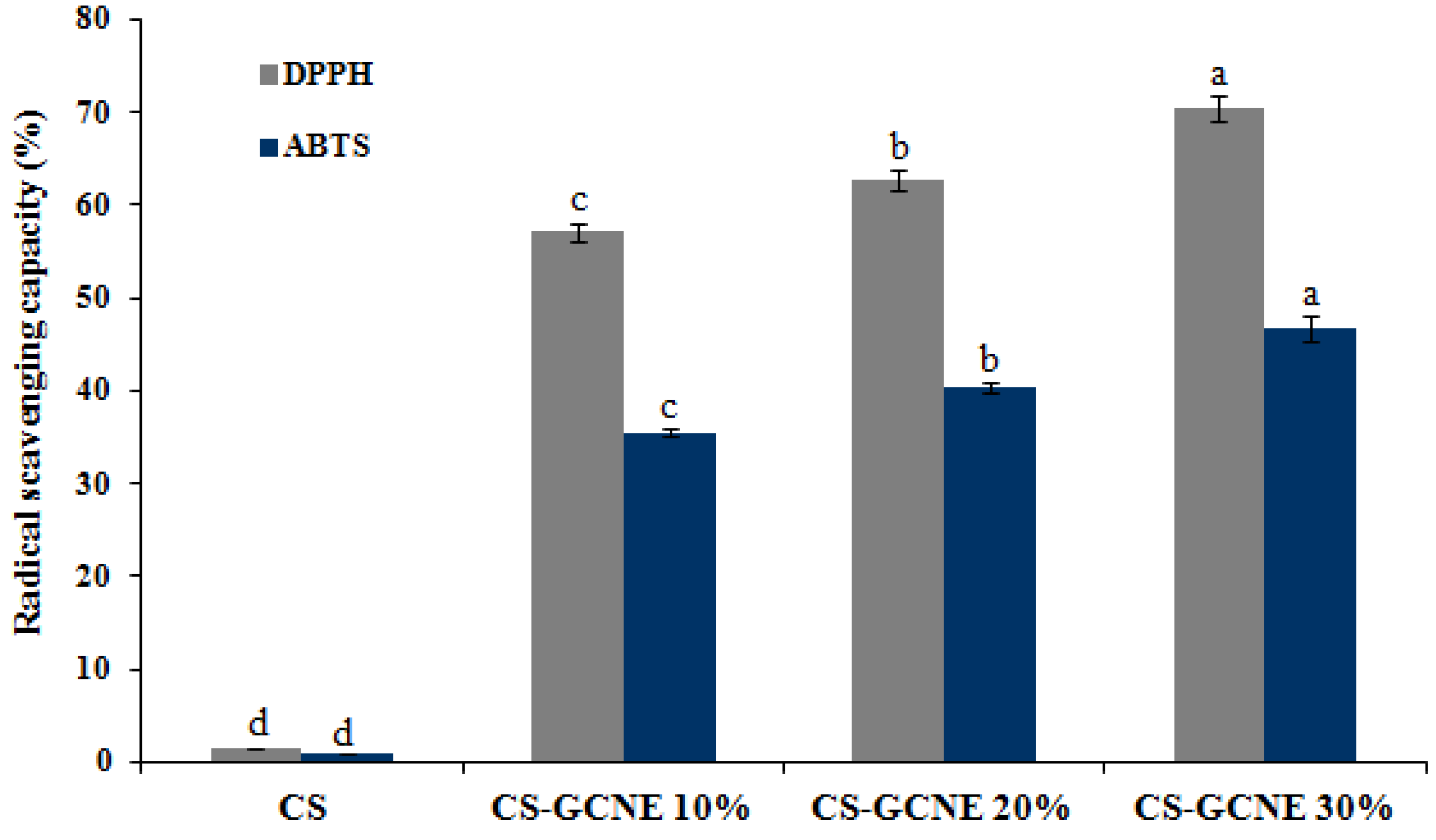
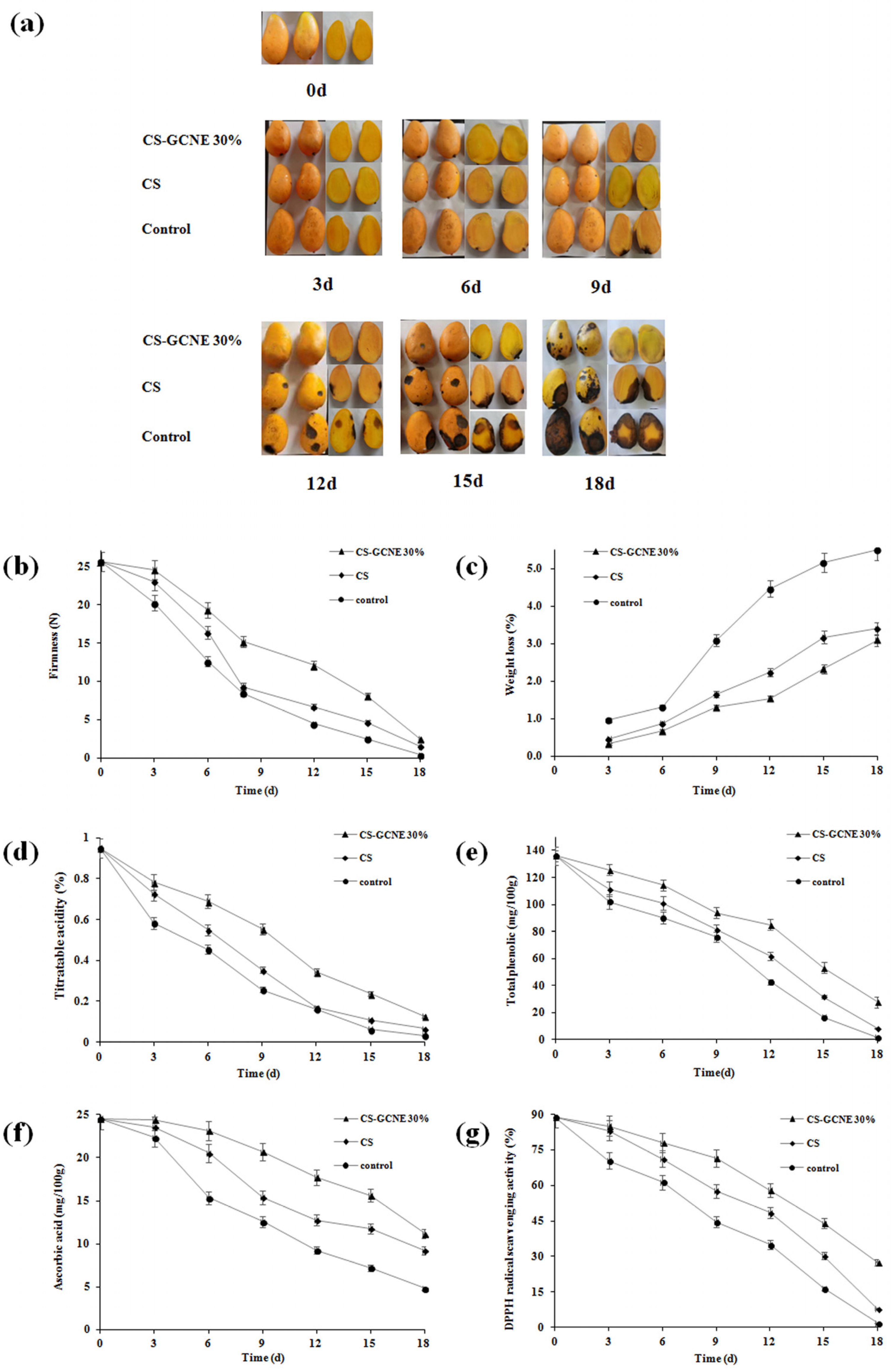
| Films | L | a | b | ∆E |
|---|---|---|---|---|
| CS | 90.35 ± 0.27 A | −0.60 ± 0.60 B | 1.55 ± 0.19 A | 2.20 ± 0.18 C |
| CS-GCNE 10% | 81.14 ± 0.43 B | 4.88 ± 0.44 A | 1.90 ± 0.13 A | 81.31 ± 0.45 A |
| CS-GCNE 20% | 79.53 ± 0.65 C | 4.99 ± 0.40 A | 0.35 ± 0.35 C | 79.69 ± 0.63 B |
| CS-GCNE 30% | 78.48 ± 1.14 C | 5.14 ± 0.70 A | −1.01 ± 0.54 C | 78.55 ± 1.12 B |
| Films | MR (%) | WA (%) | WVP (10−11 g m−1s−1Pa−1) |
|---|---|---|---|
| CS | 16.68 ± 0.81 A | 80.65 ± 0.55 A | 0.96 ± 0.029 A |
| CS-GCNE 10% | 14.32 ± 0.07 B | 71.99 ± 0.64 B | 0.94 ± 0.058 A |
| CS-GCNE 20% | 12.56 ± 0.18 C | 56.89 ± 0.58 C | 0.92 ± 0.031 A |
| CS-GCNE 30% | 10.69 ± 0.18 D | 54.74 ± 0.74 C | 0.91 ± 0.020 A |
Disclaimer/Publisher’s Note: The statements, opinions and data contained in all publications are solely those of the individual author(s) and contributor(s) and not of MDPI and/or the editor(s). MDPI and/or the editor(s) disclaim responsibility for any injury to people or property resulting from any ideas, methods, instructions or products referred to in the content. |
© 2024 by the authors. Licensee MDPI, Basel, Switzerland. This article is an open access article distributed under the terms and conditions of the Creative Commons Attribution (CC BY) license (https://creativecommons.org/licenses/by/4.0/).
Share and Cite
Tao, R.; Zheng, X.; Fan, B.; He, X.; Sun, J.; Sun, Y.; Wang, F. Enhancement of the Physical and Functional Properties of Chitosan Films by Incorporating Galla chinensis Extract. Antioxidants 2024, 13, 69. https://doi.org/10.3390/antiox13010069
Tao R, Zheng X, Fan B, He X, Sun J, Sun Y, Wang F. Enhancement of the Physical and Functional Properties of Chitosan Films by Incorporating Galla chinensis Extract. Antioxidants. 2024; 13(1):69. https://doi.org/10.3390/antiox13010069
Chicago/Turabian StyleTao, Ran, Xiuxia Zheng, Bei Fan, Xuemei He, Jian Sun, Yufeng Sun, and Fengzhong Wang. 2024. "Enhancement of the Physical and Functional Properties of Chitosan Films by Incorporating Galla chinensis Extract" Antioxidants 13, no. 1: 69. https://doi.org/10.3390/antiox13010069
APA StyleTao, R., Zheng, X., Fan, B., He, X., Sun, J., Sun, Y., & Wang, F. (2024). Enhancement of the Physical and Functional Properties of Chitosan Films by Incorporating Galla chinensis Extract. Antioxidants, 13(1), 69. https://doi.org/10.3390/antiox13010069





